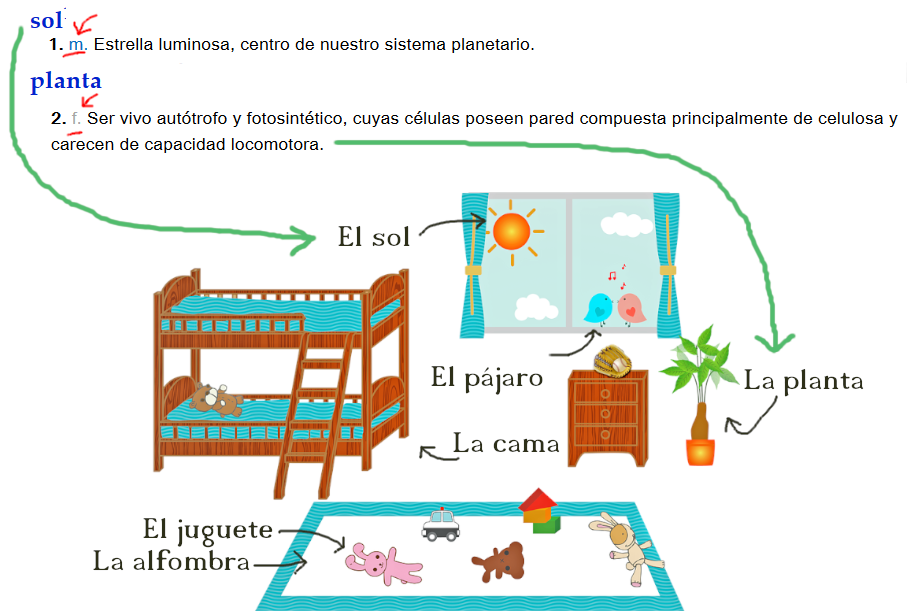The Gender in Spanish
Contents
Gender is a grammatical property inherent in nouns. According to their gender, in Spanish, the nouns are masculine or feminine. There are no neutral nouns but careful because there is a neutral article (lo) although it can only be used with adjectives (lo amarillo te sienta muy bien) and adverbs (me impresiona lo lejos que has llegado).
The fundamental property of the genre is to mark the agreement between the noun and the rest of the words with which it is combined. In the dictionary, you will find the abbreviations m. for masculine nouns, and f. for feminine nouns.
If you are looking for a trustful dictionary try RAE, Spain’s official royal institution.

Gender in Spanish language
There were three genres in Latin: masculine, feminine and neuter. Romance lost the neutral gender, except for the pronouns (lo, esto, eso, esto) and the articles (lo). That’s why all Spanish nouns are either masculine or feminine.
The genre of Latin nouns was not necessarily linked to the ending. In other words, there were male and female names in all the declensions. However, the feminine ones predominated among those ending in -a, and the masculine ones among those ending in -us.
Spanish generalized by analogy this predominance and tended to make feminine or masculine the nouns as they will end in -a or in -o, respectively, with some exceptions like día and mano (you’ll find all exceptions later in this post).

Does Spanish language have gender rules?
One of the most frequently asked questions is whether there are gender rules and definite articles in Spanish. Well, just like English language, Spanish language too has grammatical rules.
So, Spanish is definitely a gender-sensitive language and you must be careful about these gender rules to speak Spanish flawlessly. With a little effort, you will be able to master these rules.
📌 It might interest you: «Learn from the best: Best 10 pieces of advice from Polyglot Steve Kaufman (16 languages spoken)»
How many genders are there in Spanish?
Spanish has two genders: masculine and feminine. Just like any other language, the use of these genders is guided by grammatical rules. Rules that you are just about to learn.
Grammatical gender in Spanish
To begin with, always remember that all nouns have gender in Spanish. Every noun in Spanish begins with a specific article that essentially denotes the gender. They can be definite or indefinite.
The four forms that the Spanish definite articles take are el, la, los and las.

Spanish gender rules
- If a noun is singular masculine, it starts with el. For example, the boy → el niño.
- If a noun is singular feminine, it starts with la. For example, the girl → la niña.
- If a noun is masculine plural, it starts with los. For example, the boys → los niños.
- If a noun is feminine plural, it starts with las. For example, the girls → las niñas

Do numbers have genders in Spanish?
For a beginner who is learning Spanish, it is natural to wonder if numbers have genders in Spanish. Numbers are mostly masculine in Spanish. Henceforth, they begin with the article el:
- El uno means number one
- El dos means number two
- El tres means number three
- and so on
Dates are also masculine in Spanish:
- El cinco de Mayo
- El trece de Agosto
- El once de Septiembre
- and so on
However, it is worthwhile to remember that if numbers work as adjectives, their gender might change to feminine.

📌 It might interest you: «How to get a Spanish Tutor (almost) for free»
Do colors have genders in Spanish?
The gender of colors depends in the first place on how the word works in the context:
- If the color is used as a noun, it will always have a masculine gender (el azul, el rosa, el gris, el naranja, etc.).
🔹 Example: El verde es mi color preferido
- In cases where the word that designates a color is used as an adjective, if it has two endings (rojo/roja, amarillo/amarilla, etc.), its gender is subject to the gender of the noun they qualify. If it has just one ending (verde), it does not change.
🔹 Examples:
Ana se compró una falda amarilla / Ana se compró un coche amarillo
El reloj de Javier es verde / La camisa de Javier es verde
- When the color is modified by an adjective both words will appear in masculine since the noun is still the word «color» and color is masculine.
🔹 Examples:
La moto rojo oscuro es la de mi hermana.
El pantalón de su traje es negro claro.
Gender exceptions in Spanish
Spanish is one of the most interesting languages and consists of a set of predefined rules. These rules ensure that no error is committed while writing or speaking Spanish, including writing the names of colors, numbers and genders.

la in Spanish
There definitely exists some gender exceptions in Spanish. While we have learned that nouns ending in -o are masculine, there are some nouns that are feminine and yet they end at -o. Here are some examples:
- la foto → the photo
- la mano → the hand
- la moto → the motorbike
- la radio → the radio
el in Spanish
Similarly, there are several exceptions with words ending in -a that are masculine. Want some more examples?
- el aroma → the flavor
- el carisma → the charisma
- el clima → the climate
- el cometa → the comet
- el cura → the priest
- el día → the day
- el dilema → the dilemma
- el diploma → the diploma
- el enigma → the enigma
- el fantasma → the ghost
- el idioma → the language
- el mapa → the map
- el mediodía → the midday
- el Papa → the Pope
- el pijama → the pajamas
- el planeta → the planet
- el poema → the poem
- el problema → the problem
- el programa → the programme
- el sistema → the system
- el sofá → the sofa
- el tema → the subject
Masculine and Feminine Spanish
Sometimes it is said that Spanish is a sexist language because when there is a mixed group (chicos y chicas, hombres y mujeres, niños y niñas…), the masculine plural is used to encompass both male and female gender. So just by saying «chicos» you might be referring to chicos AND chicas.
The explanation is very simple. In Spanish, when there is a mixed group of men and women, the plural masculine encompasses everyone, men and women. For example, when I say «mis padres no están en casa» I mean «mi padre y mi madre«.
Nowadays, new technologies have transformed the way of writing. The use of symbols such as @ (arroba), can try to avoid sexist forms. It is common in the current times to use «Chic@s«, «Tod@s» or «Niñ@s» to encompass both male and female.

Gender of nouns in Spanish
I have prepared two lists for you that you can download below. In these lists, you will find the 220 most common words in Spanish and its gender.
To make things easier, I have divided the words into masculine and feminine, so you can download and print the one you need at every moment.
In each list, the words are organized alphabetically so it will be very easy to find what you are looking for. I have also added the corresponding article (la/el) and its translation into English.
list of masculine nouns in Spanish
⬇️
list of feminine nouns in Spanish
⬇️
📌 It might interest you: «How to learn vocabulary words fast and effectively»
Gender of nouns in Spanish worksheet
Ready to practice the gender in Spanish? Master the articles and the gender of nouns in Spanish with this worksheet. You can download it, print it or share it. It’s free and it’s for you!
At the end you will find the correct answers so you can check yours out. Every correct answer adds 1 point. Wrong answers do not count. Add up all your points and test yourself.
Remember that there are NOT any rules explained in this worksheet. Only Exercises. Read the article above to master the masculine and the feminine in Spanish.


The list of exceptions is very useful. I used to have a tinycard deck to repeat these over and over, because at first a language learner might perceive them as «mismatching».
It might be worth noting that nouns ending in -íon and -ad are always(?) feminin, while those ending in -dor usually seem to be masculine.
And to complete this maybe some explanations on nouns starting with stressed A or Ha and therefore have the masculine article despite being feminin (e.g. «el ala rota» vs «las alas rotas»).
The most common genders are called masculine and feminine, while some Spanish pronouns are considered to have neutral gender. A few nouns are said to be of «ambiguous» gender, meaning that they are sometimes treated as masculine and sometimes as feminine.
Excellent post. I have bookmarked your site.